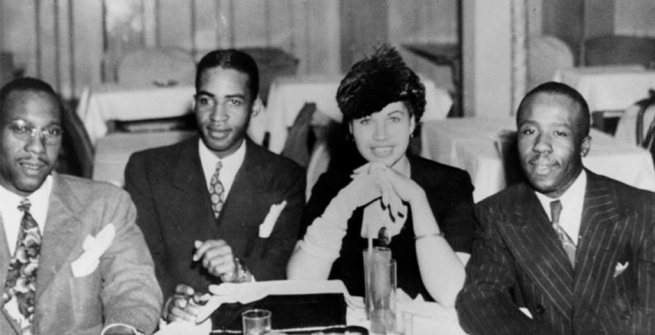Whether you want it hot or cool, swingin’ or slow, Dixieland or experimental, there’s jazz to fit your mood, mellow you out, pick you up. Jazz was born in New Orleans—the only place in the U.S. in the 1800s where slaves were allowed to own drums. This ability to own drums led many African slaves (particularly those from West Africa) to play their traditional music in order to keep their musical heritage alive. As New Orleans was a huge seaport, this traditional music became mixed with rhythms heard from ships coming from Cuba, the Caribbean and other islands, as well as from Europe. This hybrid music often incorporated lyrics from slave songs and spirituals.
When slavery was abolished in 1865, many slaves began musical careers, bringing this American-born and ever-evolving musical style to other parts of the country and later to the world. The word “jazz”—originating from the slang term “jasm” which meant pep or energy—came to encompass this new style of music. The earliest written use of the word “jazz” is in an April 2, 1912 article in the Los Angeles Times. Ben Henderson, a pitcher for minor league baseball team Portland Beavers, described his pitch as a jazz ball “because it wobbles and you simply can’t do anything with it”.
Jazz—considered to be America’s classical music—found a home in Los Angeles. The photo collection at the Los Angeles Public Library documents jazz in the City of Angels—clubs, concerts, big names, local bands—and shows that jazz is as diverse as Los Angeles itself.
In 1915, the California Eagle—an African-American-owned Los Angeles newspaper—began to refer to Central Avenue as the “Black Belt of the City”. Local businesses and churches promoted the area to African Americans and their efforts spurred a steady increase in African-American ownership of stores, restaurants, and other businesses as well as homes during the 1920s and 1930s. The 1940s, however, was a watershed moment for Central Avenue. Over 50,000 African Americans moved into the area during WWII—many to work in munitions factories and other defense-related jobs—and took up residence in and around the area south of downtown. Central Avenue, often referred to as “the Avenue”, boasted jazz clubs that were the place to hear live jazz performed by newcomers, up-and-comers, and jazz greats. Legendary music producer Quincy Jones stated, “I didn’t know where Sunset Boulevard was when I moved to L.A., but I sure knew Central.”
Club Alabam, originally titled The Apex Room, was a very popular jazz club located next to the Dunbar Hotel on Central Avenue in Los Angeles. Owned and operated by Curtis Mosby—“the mayor of Central Avenue”—it was one of the ritziest clubs in the area and was often visited by Hollywood’s elite as well as regular folk who wanted to enjoy a live show as well as good food.
The DownBeat was one of the first clubs to feature bebop music, was a favorite hangout for gangster Mickey Cohen, and was the scene for West Coast jazz great Charlie Parker’s return to performing after serving a stint in prison.
The Lighthouse, a club/café in Hermosa Beach, began showcasing jazz in May of 1949. Featuring traveling groups and also its own Lighthouse All-Stars, the venue (known as the home of modern jazz on the West Coast) was the site of many recordings which captured the brilliance of musicians including Cannonball Adderly, Art Pepper, Ramsey Lewis, Mose Allison, and more. The Lighthouse featured an annual Easter Week Inter-Collegiate Jazz Festival in the late 1950s.
Albert Shearing was a British-born jazz pianist who relocated to the U.S., became a citizen, and wrote over 300 jazz songs including Lullaby of Birdland, East of the Sun (and West of the Moon), and September in the Rain. He recorded for various record labels and formed his own band, the George Shearing Quintet. Blind since birth, Shearing first began playing jazz while performing with an all-blind band in London.
Getz was known as “the Sound”, Gilberto made her vocal debut with the hit song “The Girl From Ipanema”, and Burton developed the four-mallet technique of playing vibraphones and later pioneered fusion jazz. The trio performed at Shelly’s Manne-Hole, a small club in Hollywood, and drew standing-room-only crowds plus block-long lines.
Leonard Feather wrote extensively on jazz. He penned magazine articles, wrote musical reviews, compiled an encyclopedia on jazz, and also collaborated with comedian and radio/tv host Steve Allen in the creation of The Jazz Story: As Told By Steve Allen, a three-disc sound recording that captured various jazz performers performing various types of jazz between 1926 and 1957. Feather moved from London (his home town) to L.A.’s San Fernando Valley in 1960 with the goal of composing songs.
If you wanted to look at jazz as well as listen to it, you would turn to jazz photographer Bob Douglas. Douglas began photographing local jazz clubs in Detroit before moving to Los Angeles in 1948. Working as a freelance photographer for various newspapers and private clients, he captured the L.A. jazz scene including the historic Central Avenue clubs, immortalizing jazz greats such as Nat King Cole, Duke Ellington, and Charlie Parker. Here the camera is turned on him.
Arnold Frank was the owner of Drum City, selling new and used drum sets and providing drum instruction. Cleopatra was onsite to advertise an upcoming event for teenagers (which included jazz and drums but not lions). In jazz lingo, Cleo and Arnie are a couple of cool cats.
Written by Annie Murphy. Originally published on the Photo Friends Blog on May 6, 2019.




















